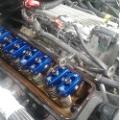Code:
26F2 bt3_26f2_3dlkup_table_sizes:
26F2 db $00, $00, $05
26F5 bt75?_26f5_what_bpw_related_f(cooltmp,load):
26F5 db $45, $56, $5C, $62, $68, $45, $56, $5C, $62, $68
26FF db $45, $56, $5C, $62, $68, $45, $56, $5C, $62, $68
2709 db $40, $50, $56, $5B, $61, $2E, $39, $3E, $43, $48
2713 db $24, $2C, $31, $36, $3A, $1B, $21, $25, $2A, $2E
271D db $17, $1C, $21, $26, $2B, $13, $18, $1D, $22, $28
2727 db $0F, $13, $18, $1E, $23, $0A, $0C, $12, $18, $1E
2731 db $06, $08, $0A, $0C, $0E, $06, $08, $0A, $0C, $0E
273B db $06, $08, $0A, $0C, $0E
it's 5 columns of MAP by 15 rows of coolant temperature (picture attached).
Code:
;; lkup3d_sub: ; A row, B col, X tbl addr, A returned val
65AA A0 00 subA 0, X ; CALC ROW ARG OFFSET, (LIMITED TO 0)
65AC 24 01 bcc @244
65AE 4F clrA ; ... ELSE
65AF E0 01 @244 subB 1, X ; CALC COL ARG OFFSET, (LIMITED TO 0)
65B1 24 01 bcc @245
65B3 5F clrB ; ... ELSE
65B4 3C @245 pushX ; XFER TABLE ADDR TO Y REG
65B5 18 38 popY
65B7 36 pushA ; SAVE ROW ADDRESS
65B8 86 10 ldaA #$10 ; SPLIT COL ARG INTO TABLE OFFSET
65BA 3D mul ; & INTERP PORTION
65BB 37 pushB ; SAVE INTERP PORTION TO STACK
65BC 16 tAB
65BD 3A aBX
65BE 33 popB
65BF 32 popA ; GET ROW ARG
65C0 37 pushB
65C1 C6 10 ldaB #$10 ; SPLIT ROW ARG INTO R
65C3 3D mul ; TABLE NUMBER
65C4 37 pushB ; (MAX RESULT IS 255D)
65C5 18 E6 02 ldaB 2, Y
65C8 3D mul
65C9 3A aBX
65CA 3C pushX
65CB 18 E6 02 ldaB 2, Y
65CE 3A aBX
65CF 18 30 tSY
65D1 EC 03 ldD 3, X
65D3 10 sBA
65D4 18 E6 03 ldaB 3, Y
65D7 24 06 bcc @246
65D9 40 negA
65DA 3D mul
65DB A9 03 adcA 3, X
(ADMAP-26)*151*2/256 is calculated as:



 Reply With Quote
Reply With Quote



Bookmarks